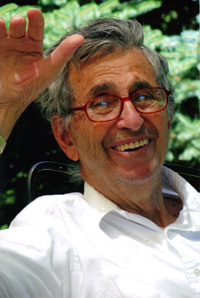In Memoriam: Joseph A. Sayeg
1925-2011
by Ralph C. Christensen

♦♦♦
To view the HPS History Committee interview with Joe Sayeg, click here.
♦♦♦
Joseph A. Sayeg, a long-time member of the Health Physics Society (HPS) and the American Association of Physicists in Medicine (AAPM), died in Lexington, Kentucky, on 31 March 2011 at age 85. He had battled leukemia for a number of years, had been bedridden for the past 18 months, and was under hospice care for much of that time.
Joe is perhaps best remembered by many HPS members as a tall, black-haired man carrying a large camera one-handed as he walked around annual meetings taking pictures for the History Committee. From early childhood he had a short leg and a withered hand, but did not let that hold him back. If you ever wondered why he only wore clip-on bow ties, think about trying to tie a tie with one hand!
He was an active participant in service activities in both the HPS and the AAPM, including several years as examiner for the American Board of Radiology (ABR). He was a member of the American Board of Health Physics (ABHP) and its Examination Committee. He chaired the Medical Physics Academic Program Directors group from 1982 to 1984. He also served as president and as secretary-treasurer of the Bluegrass Chapter of the HPS.
Joe had a lighter side; he loved to annually invite friends and students to his backyard to have lamb shish-ka-bob. Also, in the 70s and early 80s the Bluegrass Chapter, with Joe hosting, biannually would have a Casino Night at the University of Kentucky’s Spindletop Hall, using printed bills with photographic likenesses of various chapter members. A good time was always had by all!
Professionally, Joe was probably best remembered as the founding father of the medical physics and health physics academic (MS) programs begun in 1968 at the University of Kentucky. However, he had a very significant career in dose research and measurement, especially with regard to densely ionizing radiations, for many years prior to that point.
He attended the University of California at Berkeley, earning an AB in physics (1947) and a PhD in biophysics (1954). His PhD thesis was printed as a University of California Radiation Laboratory Report, “The Effect of Highly Ionizing Radiations in Cell Survival,” and resulted in a publication in Volume 1 of Radiation Research (1954).
Between 1954 and 1961 he worked at Los Alamos National Laboratory, making radiation measurements for the Biomedical Research Group under Wright Langham, authoring and coauthoring 20 Los Alamos Scientific Laboratory reports, most of which involved neutron and other densely ionizing radiation dosimetry.
It was also in Los Alamos that he and his beloved wife Margaret adopted two babies. Jim and Janine, their spouses, and their six children were with Joe at the time of his death; Margaret had died 11 years ago.
Between 1961 and 1966 Joe worked as a scientific specialist for Edgerton, Germeshausen, and Grier, Inc., in Santa Barbara, performing dosimetry research and authoring several more in-house reports.
He then moved to the University of Pittsburgh as associate professor of health physics and associate director of the whole-body counting facility.
In 1968 he accepted the position of associate professor in radiation medicine at the University of Kentucky and remained there until retirement in 1994, serving as an academic medical physicist and academic program director. By 1968, he had 17 refereed publications in addition to all the in-house reports referenced above. Joe was Board certified by the ABHP in 1967 and by the ABR in radiological physics in 1969.
At the University of Kentucky, Joe designed, developed, and directed a three-track academic sequence leading to an MS in health physics, an MS in therapeutic medical physics, or an MS in radiation biology. The only active track today is the Commission on Accreditation of Medical Physics Educational Programs, Inc., which is highly regarded in the medical physics community.
Joe personally recruited and taught nearly 100 students, two of whom later became presidents of the AAPM and all of whom have been highly competent practitioners.
In the classroom, Joe was a teacher with very high expectations, always demanding knowledge of the theoretical underpinnings underlying actual practice.
He was a kind and helpful mentor to students and colleagues and would always have good suggestions about how to address issues that arose. He will be sorely missed by his family, friends, and colleagues.



